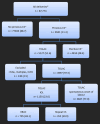May the indication for a previous cesarean section affect the outcome at trial of labor in women with induction of labor? A retrospective cohort study
- PMID: 39526317
- PMCID: PMC11683529
- DOI: 10.1111/aogs.15005
May the indication for a previous cesarean section affect the outcome at trial of labor in women with induction of labor? A retrospective cohort study
Abstract
Introduction: Cesarean sections are increasing worldwide and are associated with altered risks of complications for both mother and child. Vaginal birth after cesarean section is associated with lower maternal and neonatal morbidity than in repeat cesarean section. Only a few studies have considered the indication for the previous cesarean section to be of importance for the outcome of subsequent labor. The aim of this study was to evaluate whether the indication for a previous cesarean section affects the outcomes at a subsequent delivery in women with induction of labor.
Material and methods: This retrospective cohort study of the four largest delivery units in Stockholm during 2012-2015 included 1150 women with one previous cesarean section with induction of labor.
Inclusion criteria: women with induced labor and a previous cesarean section, singleton pregnancy, cephalic presentation, gestational age of ≥34 weeks. The women were grouped by indication for the previous cesarean section.
Primary outcome: mode of delivery (vaginal birth after previous cesarean section or repeat cesarean section).
Secondary outcomes: induction to delivery time, postpartum hemorrhage, uterine rupture. Neonatal outcomes: birth weight, Apgar score <7, arterial umbilical cord blood gas pH <7.0.
Results: Our study found that the indication of labor dystocia at the previous cesarean section, increased the risk of repeat cesarean section (aOR 5.35; 95% CI: 1.64-17.50) in women with induction of labor. Other risk factors for repeat cesarean section were birth weight >4000 g, maternal BMI ≥30 or if vaginal prostaglandin was used as the method for induction of labor. A previous vaginal delivery and use of oxytocin increased the chance of a vaginal delivery in this group of women.
Conclusions: Our study showed that the indication for the previous cesarean section affects the outcome in the subsequent delivery in women with induction of labor. If the indication for the previous cesarean section was labor dystocia, the risk of repeat cesarean section was increased.
Keywords: TOLAC; VBAC; induction of labor; labor dystocia; previous vaginal delivery; repeat cesarean section.
© 2024 The Author(s). Acta Obstetricia et Gynecologica Scandinavica published by John Wiley & Sons Ltd on behalf of Nordic Federation of Societies of Obstetrics and Gynecology (NFOG).
Conflict of interest statement
The authors declare no conflicts of interest.
Figures
Similar articles
-
Success of trial of labor in women with a history of previous cesarean section for failed labor induction or labor dystocia: a retrospective cohort study.BMC Pregnancy Childbirth. 2019 May 20;19(1):176. doi: 10.1186/s12884-019-2334-3. BMC Pregnancy Childbirth. 2019. PMID: 31109302 Free PMC article.
-
Delivery for women with a previous cesarean: guidelines for clinical practice from the French College of Gynecologists and Obstetricians (CNGOF).Eur J Obstet Gynecol Reprod Biol. 2013 Sep;170(1):25-32. doi: 10.1016/j.ejogrb.2013.05.015. Epub 2013 Jun 28. Eur J Obstet Gynecol Reprod Biol. 2013. PMID: 23810846 Review.
-
Balloon catheter for induction of labor in women with one previous cesarean and an unfavorable cervix.Acta Obstet Gynecol Scand. 2019 Jul;98(7):920-928. doi: 10.1111/aogs.13558. Epub 2019 Mar 7. Acta Obstet Gynecol Scand. 2019. PMID: 30723900 Free PMC article.
-
[The outcome of trial of labor after cesarean section].Zhonghua Fu Chan Ke Za Zhi. 2016 Oct 25;51(10):748-753. doi: 10.3760/cma.j.issn.0529-567X.2016.10.008. Zhonghua Fu Chan Ke Za Zhi. 2016. PMID: 27788742 Chinese.
-
Trial of labor after cesarean delivery in twin gestations: systematic review and meta-analysis.Am J Obstet Gynecol. 2019 Apr;220(4):336-347. doi: 10.1016/j.ajog.2018.11.125. Epub 2018 Nov 19. Am J Obstet Gynecol. 2019. PMID: 30465748
References
-
- Network Ep . European Perinatal Health Report Core indicators of the health and care of pregnant women and babies in Europe from 2015 to 2019. https://www.europeristat.com/images/Euro‐Peristat_Fact_sheets_2022_for_u...: Euro peristat 2022.
-
- Jackson S, Fleege L, Fridman M, Gregory K, Zelop C, Olsen J. Morbidity following primary cesarean delivery in the Danish National Birth Cohort. Am J Obstet Gynecol. 2012;206(139):e1‐e5. - PubMed
-
- Qiu L, Zhu J, Lu X. The safety of trial of labor after cesarean section (TOLAC) versus elective repeat cesarean section (ERCS): a systematic review and meta‐analysis. J Matern Fetal Neonatal Med. 2023;36:2214831. - PubMed
MeSH terms
LinkOut - more resources
Full Text Sources


